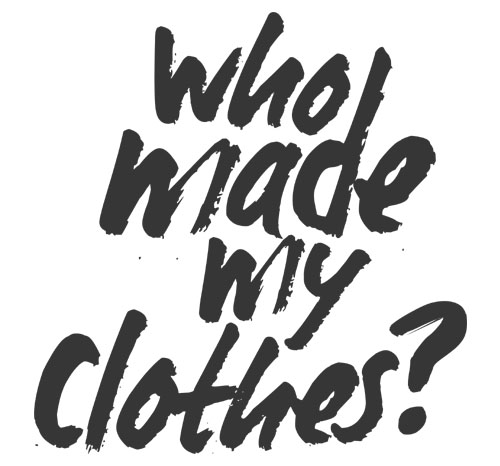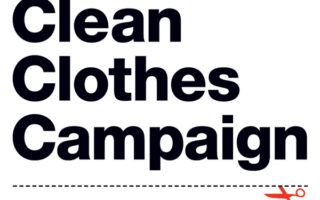I was recently asked to collaborate with the team behind Fashion Revolution Day and was given an info pack containing loads of interesting statistics & information about the garment industry that I simply had to share!

Discover these illuminating facts & figures for yourself and learn more about who makes your clothes:
Industry and Cotton Facts:
– An estimated 100 million rural households are involved in the production of cotton in 70 countries around the world.
– Two-thirds of this cotton is produced in the developing world. For most cotton farmers in cotton-producing communities it is their only means of income and their only cash crop.
– In West Africa for example, cotton makes up to 40% of export income.
– Many cotton farmers also live in poverty — trying to survive on less than $2 a day. World prices on cotton have been unstable for a long time and farmers have been severely affected by the falling prices. Things are getting harder, not easier. Cotton farmers are under pressure from rising input costs of fuel, pesticides and insecticides. This means that few farmers can cover the cost of production, because they cannot pass these costs on when cotton is sold at such a low price.
– Cotton farmers in the United States, the EU and China are highly subsidized leading to overproduction. When their huge volumes of cotton are dumped on world markets, prices are driven down and small-scale cotton farmers cannot compete.
– The retail manufacturing industry is the second most polluting industry on Earth, second only to oil. (Fashioning Change)
– The fashion industry employs a sixth of the world’s population. (Fashioning Change)
– We have four times as many clothes in our wardrobes than in 1980 and we get rid of the same amount every year.
– At least 8,000 chemicals are used to turn raw materials into clothes, many of these are toxic and pollute the environment, local water and also cause lasting harm to workers. (Greenpeace)
– There are 20,000 deaths per year as a result of pesticide poisoning, many working in cotton agriculture in the developing world. (EJF)
– 2/3 of all cotton is produced in developing countries — 100 million rural households depend on cotton for survival (Fairtrade)
The State of Transparency Today:
– Only 4 out of 10 businesses are looking beyond conventional approaches to sustainability in supply chains — that have shown limited results (Deloitte, 2013).
– 61% of companies didn’t know where their garments were made. 76% didn’t know where their fabric was woven, knitted or dyed, and 93% didn’t know the origins of the raw fiber. (Baptist World Aid Australia 2013)
– Companies with strong ethical commitments have historically outperformed the average: an index of the World’s Most Ethical Companies showed that these organizations outperformed the Standard & Poor 500 and FTSE 100 every year from 2005 to 2010 (Institute of Business Ethics).
– 2 out of 3 fashion companies are not focused on engaging consumers with regard to sustainability (Deloitte 2013)
What Consumers Think about Transparency:
– A new poll for the campaign, conducted by YouGov/Global Poverty Project, concluded that: 78% of shoppers do not believe that UK clothes companies are transparent enough about their supply chains (i.e. the conditions of workplaces they use and also the wages of those employed
– 76% believe that companies should be transparent and upfront about the conditions of the factories where their goods are produced and the wages earned by the workers
– 74% said they would be likely to pay an extra five per cent for their clothes if there was a guarantee workers were being paid fairly and working in safe conditions
THE GLOBAL FASHION INDUSTRY HAS ENORMOUS UNREALIZED POTENTIAL TO CHANGE THE WORLD!
– The global fashion industry (encompassing textiles, apparel, accessories, footwear and luxury goods) is worth over $2.5 trillion and employs around 60 million people worldwide. Apparel, accessories and luxury goods account for over 55% of this market and the expected yearly growth rate through 2015 is 4% annually. (Global Apparel Market 2013)
– The Textile, Clothing and Footwear sectors (TCF) are one of the most globalized sectors, providing employment opportunities to more than 60 million people worldwide. (ILO 2013)
Fashion specifically, so not textiles or manufacturing, employs about 4.2 million people and is worth $1.2 trillion revenue (OTEXA 2013)
The Fashion & Textiles Industry Represents over 1% of the Global population:
– 1% of the world’s population is employed by the fashion and textiles sector. If we assume the fashion industry mainly employs people in USA, Europe, UK, and other developed countries, then as much as 94% of those employed in these industries are located in the developing world and are employed in textiles and manufacturing. (NB. big assumption but case could be made)
– Fashion is one of the most polluting industries in the world, second only to oil in terms of its environmental impact. 25% of chemicals produced worldwide are used for textiles and the industry is often noted as the number 2 polluter of clean water — after agriculture (Danish Fashion Institute 2013).
Disclaimer: I am not at all an expert on the big business of fast fashion however I am a concerned consumer who has chosen to learn & share as much as I can through my own personal experiences & the wealth of resources available online.
Discover how to use what you have to create what you want at RefashionistaSheri.com









Thank you for sharing all this information. Info pack information like you personally received, would be better served if shared more widely, like you have done. Awesome contribution to FRD globally!